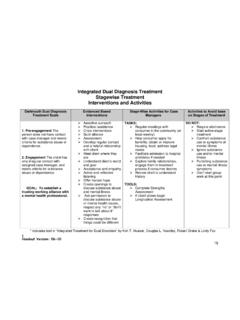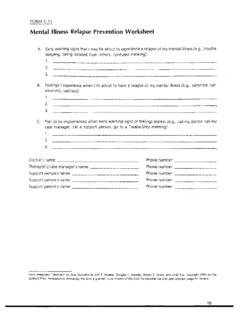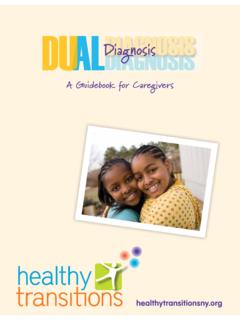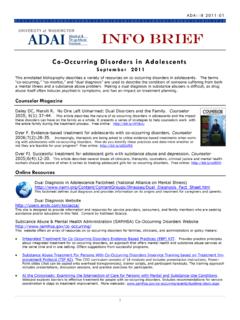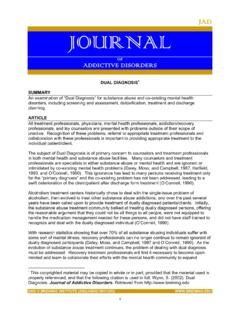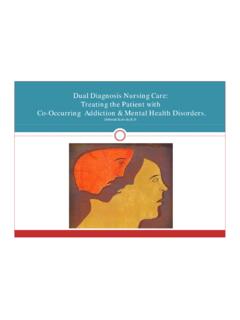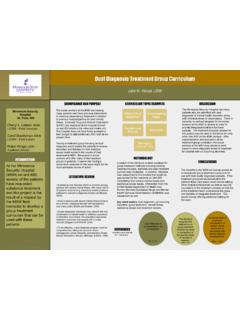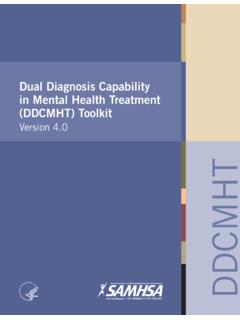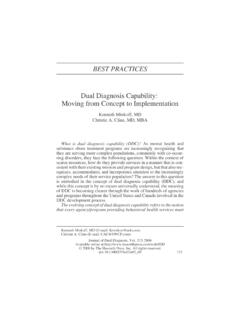Transcription of Integrated Dual Diagnosis Treatment Stagewise Treatment ...
1 * indicates tool in Integrated Treatment for dual Disorders by Kim T. Mueser, Douglas L. Noordsy, Robert Drake & Lindy Fox Handout Version: 06-10 1 Integrated dual Diagnosis Treatment Stagewise Treatment Interventions and Activities Dartmouth dual Diagnosis Treatment Scale Evidenced Based Interventions Stage-Wise Activities for Case Managers Activities to Avoid base on Stages of Treatment 1. Pre-engagement The person does not have contact with case manager and meets criteria for substance abuse or dependence. 2.
2 Engagement The client has only irregular contact with assigned case manager, and meets criteria for substance abuse or dependence. GOAL: To establish a trusting working alliance with a mental health professional. Assertive outreach Practical assistance Crisis interventions Build alliance Assessment Develop regular contact and a helpful relationship with client Meet client where they are Understand client s world and goal Acceptance and empathy Active and reflective listening Offer honest hope Create openings to discuss substance abuse and mental illness Ask permission to discuss substance abuse or mental health issues.
3 Respect any no or don t want to talk about it responses Create recognition that things could be different TASKS: Regular meetings with consumer in the community (at least weekly) Help consumer apply for benefits, obtain or improve housing, food, address legal needs Facilitate admission to hospital and/detox if needed Explore family relationships, engage them in Treatment process if consumer desires Review chart to understand history TOOLS: Complete Strengths Assessment If client allows begin Longitudinal Assessment DO NOT: Require abstinence Start active-stage Treatment Confront substance use or symptoms of mental illness Ignore substance use and/or mental illness Punishing substance use or mental illness symptoms Don t start group work at this point 18* indicates tool in Integrated Treatment for dual Disorders by Kim T.
4 Mueser, Douglas L. Noordsy, Robert Drake & Lindy Fox Handout Version: 06-10 2 Dartmouth dual Diagnosis Treatment Scale Evidenced Based Interventions Stage-Wise Activities for Case Managers Activities to Avoid base on Stages of Treatment 3. Early Persuasion The client has regular contact with case manager, continues to use the same amount of substances or has reduced substance use for less than 2 weeks, and meets criteria for substance abuse or dependence. 4. Persuasion The client has regular contact with case manager, shows some evidence of reduction in use for the past 2-4 weeks (fewer substances, smaller quantities, or both), but still meets criteria for substance abuse or dependence.
5 GOAL: To help the client explore how substance abuse and mental illness impact personal goals and values, as well as eliciting change talk about pursuing recovery. Ask permission to discuss substance use and illness symptoms Education about illness and substances Set goals Build awareness of problems Assist in envisioning life without substances Develop motivation to change using motivational interviewing techniques Family support Peer support Interventions can be individual and/or and group Help establish meaningful activities (work, school, etc)
6 In client s life Work collaboratively with client in reducing use and setting reduction goals TASKS: Increase knowledge of substance use and mental illness Discuss the role of ambivalence in recovery from both illnesses Encourage consumer to explore self-help groups Offer IDDT groups (persuasion) TOOLS: Complete Longitudinal Assessment Time-line follow back calendar to assess past 7 mos use Develop a list of supportive friends and family and practice reaching out to them Complete/Update a Functional Assessment Complete a Payoff Matrix* Complete Pleasant Activities Worksheet DO NOT.
7 Require abstinence Offer too much Treatment too early (jumping to the action phase at the first mention of changing use) Ignore substance use and/or mental illness Require inpatient substance abuse Treatment 19* indicates tool in Integrated Treatment for dual Disorders by Kim T. Mueser, Douglas L. Noordsy, Robert Drake & Lindy Fox Handout Version: 06-10 3 Dartmouth dual Diagnosis Treatment Scale Evidenced Based Interventions Stage-Wise Activities for Case Managers Activities to Avoid base on Stages of Treatment 5.
8 Early Active Treatment The client is engaged in Treatment and has reduced substance use for more than the past month, but still meets criteria for substance abuse or dependence. 6. Late Active Treatment The client is engaged in Treatment and has not met criteria for substance abuse or dependence for the past 1-5 months. GOAL: To help the client decrease or stop substance use and increase management of mental illness symptoms so that they are longer problems. Integrated dual Diagnosis interventions and counseling (individual and/or group) Medication Treatment Skills training Community reinforcement: seek out work, school, church, clubs, volunteer opportunities Self-help groups Cognitive-behavioral therapy Begin relapse prevention work Offer a menu of Treatment options Normalize relapse TASKS: Join client for new sober activities Refer for Med eval.
9 To see if meds can help with reduced or no usage, cravings Explore employment or education options Help family and friends support abstinence Help client share plans to stop using Learn/practice relaxation techniques Teach anger management skills Develop list of triggers for substance use and mental illness relapse Based on functional analysis, make a plan for each trigger Develop/practice a plan for coping with cravings, high-risk situations, boredom, celebrations, Practice drink refusal skills TOOLS: Problem-solving sheet* Recovery Mountain worksheet* Relapse Prevention Worksheets (SA & MI*) Complete a Contextual Analysis* DO NOT: Punish or ignore a slip or relapse Express disappointment or judgment of a relapse or slip Premature discharge Overload consumer with goals/activities 20* indicates tool in Integrated Treatment for dual Disorders by Kim T.
10 Mueser, Douglas L. Noordsy, Robert Drake & Lindy Fox Handout Version: 06-10 4 Dartmouth dual Diagnosis Treatment Scale Evidenced Based Interventions Stage-Wise Activities for Case Managers Activities to Avoid base on Stages of Treatment 7. Relapse Prevention The client is engaged in Treatment and has not met criteria for substance abuse or dependence for the past 6-12 months. 8. Remission or Recovery The client has not met criteria for substance abuse or dependence for more than the past year. GOAL: To help the client expand recovery from both illnesses to other areas of life.
